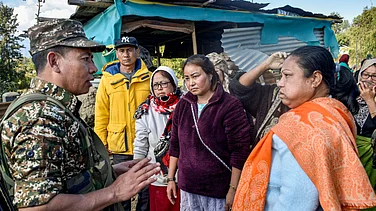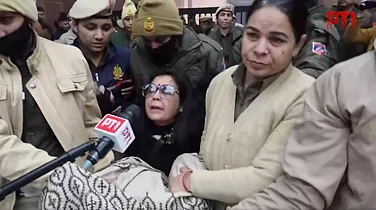In the mid-nineteenth century, a British engineer, Sir Arthur Thomas Cotton, had turned the barren plains of the Godavari basin into the rice bowl of Andhra Pradesh by laying a network of canals from the river. Sir Cotton’s statues today dot the landscape in Andhra and his name is still mentioned in prayers by millions of people in the two Godavari districts. More than 160 years later, Telangana chief minister K. Chandrasekhar Rao is looking to cast a similar legacy in the mammoth structure of the Kaleshwaram Lift Irrigation Project, India’s biggest and costliest. Some say, the world’s costliest irrigation project. But KCR’s pet project is more than just statistics. It’s a dream and hope of millions. The pride of a young state. And it’s about to be completed in August, three years after the foundation stone was laid.
Being built at a cost of Rs 80,000 crore—which could go up to Rs 1,00,000 crore—the project is expected to irrigate 18 lakh acres in 13 districts and reinforce the existing irrigation network for 17 lakh acres in seven other districts, which will virtually cover the entire state. Besides providing water to industries, the project will also supply drinking water to towns and cities, including Hyderabad and Secunderabad. For a state born just in 2014, the project is symbolic of what many believe is a rush to “undo the wrongs of history”, a euphemism frequently used to mean alleged mistreatment when it was part of Andhra Pradesh. Former Andhra chief minister, Late Y.S. Rajasekhar Reddy did lay the foundation stone for a barrage across the river Pranahita in Adilabad district, now in Telangana, but it was not enough for the vast swathes of barren land.
The Kaleshwaram project is a complex maze of reservoirs, tunnels, canals and a pipeline network originating at the confluence of the Godavari and Pranahita rivers, near the Kaleshwaram temple. At least 20 reservoirs in 13 districts will store 145 thousand million cubic feet of water, which will be distributed through a network of tunnels running up to 330 kilometres, said chief engineer Nalla Venkateswaarlu. An interconnected canal network will also carry water to farmlands as far as 500 kilometres from the Godavari. The cavernous reservoirs and serpentine tunnels have established several world records for the project—a 14.09-kilometre-long underground tunnel, the surge pool from where the mammoth pumps will operate, will hold two crore litres of water. During the peak monsoon season, the Godavari discharges 50-60 lakh cubic feet of water on an average day.

The project is, however, not without its share of controversies. The Congress-led opposition parties had opposed the shifting of the site of the barrage from Tummidihatti in Adilabad district to Medigadda in the newly carved out Bhoopalapally district of erstwhile Karimnagar. The Opposition also accused the then major irrigation minister T. Harish Rao, who happens to be the nephew of KCR, of receiving huge kickbacks in the project. Though the opposition had moved court, their plea was turned down. “We are not against the project, but only against relocating it,” says Congress MP and state unit chief Uttam Kumar Reddy. But KCR and his government have defended the barrage’s relocation, citing objections by neighbouring Maharashtra where several villages downstream would have been submerged. This would have also led to additional expenses of rehabilitating the displaced families, the government said.
The project is close to KCR’s heart and he monitors its progress daily. A powerful camera installed at the Medigadda barrage site enables him and his staff at his Hyderabad office to monitor the work as well as pass on instructions to the engineers at the site. The chief minister is also a frequent visitor to the project, especially the barrage site, which is a 300-km drive from Hyderabad.
Kondapalli Venugopal, who retired recently and was associated with the project right from its proposal stage, said that the state government made all efforts to convince Maharashtra, which had reservations about the full reservoir level of the barrage at Medigadda. The Centre gave environmental clearance in December. Engineers said that the most interesting feature of the project is that is ensures water is always kept in the river bed. As a result, the available water can be reverse-pumped into Godavari and diverted into a network of reservoirs, water tunnels, pipelines and canals.
For KCR and his party, the Telangana Rashtra Samithi, the project could also be a political game-changer, if the clean sweep in the recent local body polls is of any indication. Though assembly elections are not due till 2023, political analysts believe that it will take a couple of years for the state to reap the benefits of the project. Many of his supporters feel that KCR will be remembered as Sir Cotton solely for his achievement in completing the project.
On many of the plaques on Sir Cotton’s statues are inscribed the words ‘Apara Bhageeratha’ (the king who brought the Ganga to earth). It’s a legacy hard to beat but KCR could come close to matching the legend popularly known as ‘Cotton Dora’ (Lord Cotton).
By M.S. Shanker in Hyderabad






















